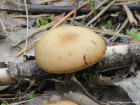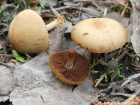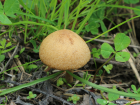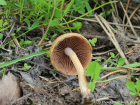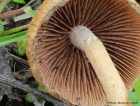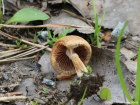Cap ochraceous-tan, becomes darker brown. It starts off convex and broadly umbonate, then expands. Initially, it is woolly and fibrous but becomes smooth over time, with a ragged margin and velar remnants. The flesh is ochraceous-brown, rather soft and thick at the centre. Gills adnexed to free, start off yellow-brown with a pale edge, but darken to mottled dark brown and eventually black with spores. When moist, the gill edges retain black watery droplets. Stem paler brown than the cap but becomes more russet towards the base. It has a fibrous texture and features a ring zone of pale fibers that quickly get stained black by falling spores. The stem remains approximately equal in size throughout. Spore print black.
Microscopic Features: The spores are ellipsoidal to lemon-shaped, warty, measuring 8-11 x 5-7μm, and possess a germ pore.
Synonyms: Lacrymaria velutina is seen as a synonym by some authors.
Lacrymaria lacrymabunda on the First Nature Web site.
Lacrymaria velutina on the MushroomExpert.Com Web site.
Many mushrooms are poisonous, and some can be lethally toxic. Distinguishing between edible and poisonous mushrooms can be very challenging. Therefore, we strongly advise against consuming wild mushrooms. This website does not contain any information about the edibility or toxicity of mushrooms.
Although efforts have been made to ensure accuracy on this website, the information may contain errors and omissions. Therefore, all content provided is for educational and informational purposes only and should not be relied upon or used as a basis for consuming any plants or mushrooms.
External links are provided for reference only. We do not endorse or take responsibility for the content, advice, or products found on these sites or in any advertisements shown on this website.
